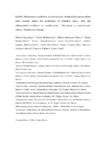Soluble inflammatory mediators of synoviocytes stimulated by monosodium urate crystals induce the production of oxidative stress, pain, and inflammation mediators in chondrocytes

View/
Use this link to cite
http://hdl.handle.net/2183/32162Collections
- Investigación (FCS) [1293]
Metadata
Show full item recordTitle
Soluble inflammatory mediators of synoviocytes stimulated by monosodium urate crystals induce the production of oxidative stress, pain, and inflammation mediators in chondrocytesAuthor(s)
Date
2021-03-16Citation
López-Reyes A, Medina-Luna D, Santamaría-Olmedo M, Martínez-Flores K, Zamudio-Cuevas Y, Fernández-Torres J, Martínez-Nava GA, Olivos-Meza A, Camacho-Rea C, Fernández-Moreno M, Blanco FJ, Pineda C. Soluble inflammatory mediators of synoviocytes stimulated by monosodium urate crystals induce the production of oxidative stress, pain, and inflammation mediators in chondrocytes : Secretome of synoviocytes induces chondrocyte damage. Clin Rheumatol. 2021 Aug;40(8):3265-3271.
Abstract
[Abstract] We hypothesized that the secretion of inflammatory mediators from synoviocytes affects the chondrocyte homeostasis of articular cartilage. This study was a preliminary attempt to elucidate the molecular mechanisms by which soluble mediators obtained from activated synoviocytes induce oxidative stress and inflammation in chondrocytes. We measured the concentrations of interleukin-6 (IL-6), interleukin-8 (IL-8), monocyte chemoattractant protein-1 (MCP-1), nerve growth factor (NGF), superoxide anion (O2•-), hydrogen peroxide (H2O2), and nitric oxide (NO•) from articular human cells. First, we created a conditional basal medium by exposing synoviocytes (HS) to monosodium urate crystals (CBM). The chondrocytes were exposed to either CBM (CCM), urate crystals directly (CMSU), or remained untreated (CC) as a negative control. Data were analyzed by ANOVA tests; Bonferroni test was performed for multiple comparisons between groups. Interestingly, we observed that mediators of inflammation and oxidative stress were significantly higher in CCM than CMSU and CC groups (P<0.01). The specific concentrations were as follows: 19.85 ng/mL of IL-6, 9.79 ng/mL of IL-8, 5.17 ng/mL of NGF, and 11.91 ng/mL of MCP-1. Of note, we observed the same trend for reactive oxygen and nitrogen species (P<0.001). Soluble mediators secreted by synoviocytes after being activated with MSU crystals (as observed in individuals who present gout attacks) trigger chondrocyte activation intensifying the articular inflammatory, oxidative, and pain states that damage cartilage in OA; this damage is more severe even when compared to HC directly exposed to monosodium urate crystals. Key Points • The molecular relation between MSU depositions and cartilage damage could be mediated by pro-inflammatory soluble mediators and oxidative molecules. • The secretion of pro-inflammatory mediators by activated synoviocytes is more harmful to chondrocytes than a direct activation in the chondrocyte culture. • Under this model, there is an important imbalance in the matrix homeostasis due to changes in several chemokines, cytokines, and other factors such as NGF, as well as oxidative mediators.
Keywords
Gout
Osteoarthritis
Oxidative mediators
Pro-inflammatory Interleukins
Secretome-activated synoviocytes
Osteoarthritis
Oxidative mediators
Pro-inflammatory Interleukins
Secretome-activated synoviocytes
Description
Brief report
Editor version
Rights
This version of the article has been accepted for publication, after peer review and is subject to Springer Nature’s AM terms of use, but is not the Version of Record and does not reflect post-acceptance improvements, or any corrections. The Version of Record is available online at Springer Link web.
ISSN
0770-3198





